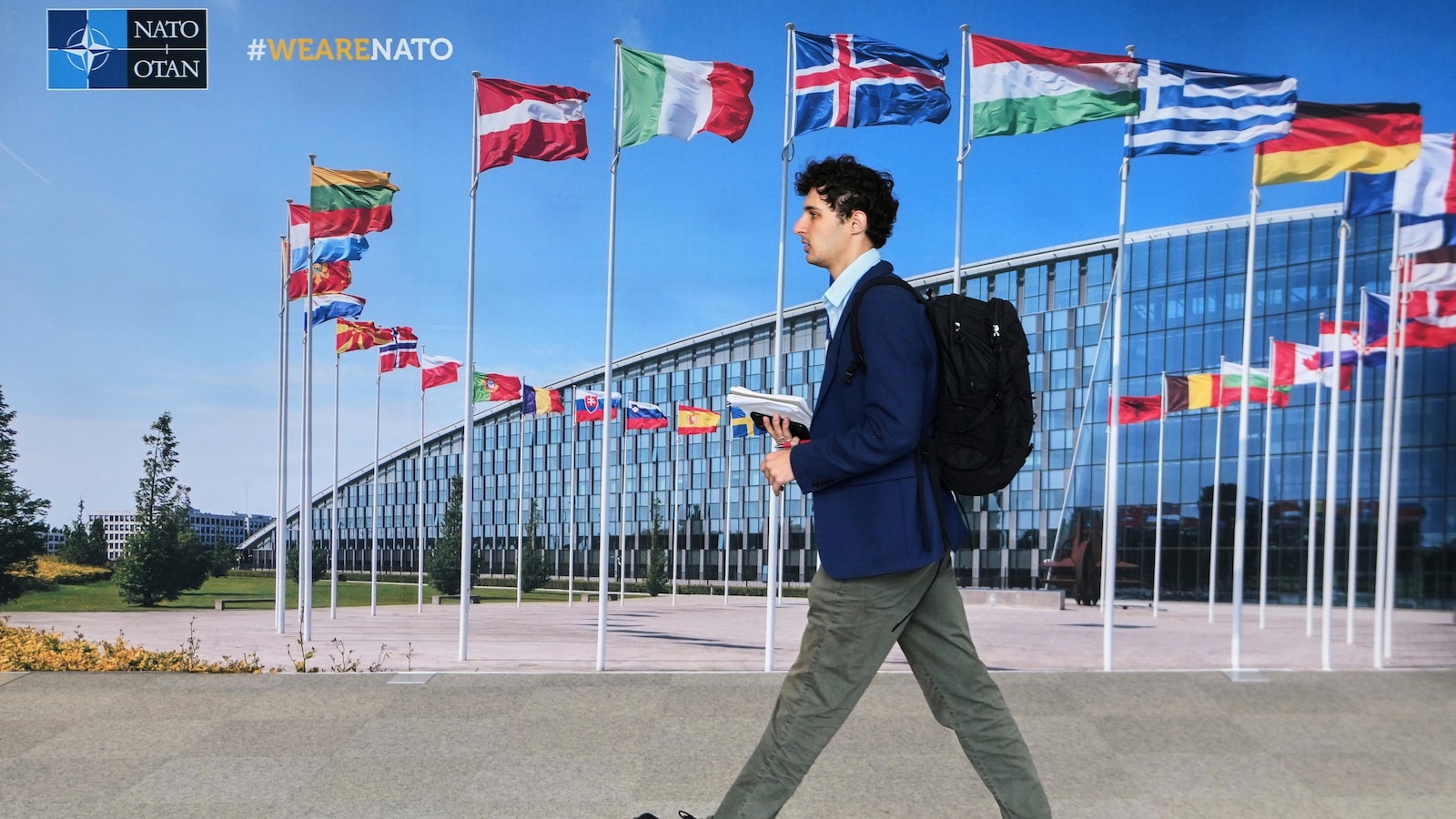NATO warns Russia it will use all means to defend against airspace breaches
BRUSSELS -- NATO warned Russia on Tuesday that it would use all means to defend against any further breaches of its airspace after the downing earlier this month of Russian drones over Poland and Estonia's report of an intrusion by Russian fighter jets last week.
The Sept. 10 incident in Poland was the first direct encounter between NATO and Moscow since the war in Ukraine began. It jolted leaders across Europe, raising questions about how prepared the alliance is against growing Russian aggression.
Another test of NATO's preparedness and credibility came last Friday, after Estonia said that three Russian fighter jets had entered its airspace for 12 minutes without authorization, a charge that Russia has rejected.
“Russia should be in no doubt: NATO and Allies will employ, in accordance with international law, all necessary military and non-military tools to defend ourselves and deter all threats from all directions,” the alliance said in a statement.
“We will continue to respond in the manner, timing, and domain of our choosing,” the 32-member NATO said, and underlined its commitment to Article 5 of its founding treaty that an attack on any one ally must be considered an attack on them all.
Asked whether suspect aircraft would be shot down, NATO Secretary-General Mark Rutte said this would depend "on available intelligence regarding the threat posed by the aircraft, including questions we have to answer like intent, armaments and potential risk to allies, forces, civilians or infrastructure.”
On Monday, Prime Minister Donald Tusk said that Poland would “without discussion” shoot down flying objects when they violate Polish territory.
Not all appear to endorse that approach. "We will always assess the situation, assess the immediate threat the plane poses,” Rutte said.
The NATO statement came after Estonia requested formal consultations under Article 4 of its treaty, which allows any alliance member to demand a meeting if it believes its territorial integrity, political independence or security is threatened. Rutte said the call for talks was “absolutely warranted.”
Rutte also said that it was “too early to say” whether a drone incident at Copenhagen Airport overnight, which shut down airspace around Scandinavia's largest airport for hours, was linked to Russia.
The airspace incidents have sparked calls for action, and raised questions about NATO's ability to deter Russia even as President Vladimir Putin wages war on Ukraine.
They also come months after the Trump administration warned Europe that it must take care of its own security, and that of Ukraine, in future, raising questions about the American commitment to the world's biggest military alliance. Threats of tough U.S. sanctions against Russia have also remained just threats.
"We see a pattern: Russia is testing European borders, probing our resolve, undermining the security of the whole of Europe. Russia will continue to provoke as long as we allow it,” EU foreign policy chief Kaja Kallas said at the United Nations on Monday.
https://abcnews.go.com/International/wireStory/nato-warns-russia-means-defend-airspace-breaches-after-125844961
BRUSSELS -- NATO warned Russia on Tuesday that it would use all means to defend against any further breaches of its airspace after the downing earlier this month of Russian drones over Poland and Estonia's report of an intrusion by Russian fighter jets last week.
The Sept. 10 incident in Poland was the first direct encounter between NATO and Moscow since the war in Ukraine began. It jolted leaders across Europe, raising questions about how prepared the alliance is against growing Russian aggression.
Another test of NATO's preparedness and credibility came last Friday, after Estonia said that three Russian fighter jets had entered its airspace for 12 minutes without authorization, a charge that Russia has rejected.
“Russia should be in no doubt: NATO and Allies will employ, in accordance with international law, all necessary military and non-military tools to defend ourselves and deter all threats from all directions,” the alliance said in a statement.
“We will continue to respond in the manner, timing, and domain of our choosing,” the 32-member NATO said, and underlined its commitment to Article 5 of its founding treaty that an attack on any one ally must be considered an attack on them all.
Asked whether suspect aircraft would be shot down, NATO Secretary-General Mark Rutte said this would depend "on available intelligence regarding the threat posed by the aircraft, including questions we have to answer like intent, armaments and potential risk to allies, forces, civilians or infrastructure.”
On Monday, Prime Minister Donald Tusk said that Poland would “without discussion” shoot down flying objects when they violate Polish territory.
Not all appear to endorse that approach. "We will always assess the situation, assess the immediate threat the plane poses,” Rutte said.
The NATO statement came after Estonia requested formal consultations under Article 4 of its treaty, which allows any alliance member to demand a meeting if it believes its territorial integrity, political independence or security is threatened. Rutte said the call for talks was “absolutely warranted.”
Rutte also said that it was “too early to say” whether a drone incident at Copenhagen Airport overnight, which shut down airspace around Scandinavia's largest airport for hours, was linked to Russia.
The airspace incidents have sparked calls for action, and raised questions about NATO's ability to deter Russia even as President Vladimir Putin wages war on Ukraine.
They also come months after the Trump administration warned Europe that it must take care of its own security, and that of Ukraine, in future, raising questions about the American commitment to the world's biggest military alliance. Threats of tough U.S. sanctions against Russia have also remained just threats.
"We see a pattern: Russia is testing European borders, probing our resolve, undermining the security of the whole of Europe. Russia will continue to provoke as long as we allow it,” EU foreign policy chief Kaja Kallas said at the United Nations on Monday.
https://abcnews.go.com/International/wireStory/nato-warns-russia-means-defend-airspace-breaches-after-125844961
NATO warns Russia it will use all means to defend against airspace breaches
BRUSSELS -- NATO warned Russia on Tuesday that it would use all means to defend against any further breaches of its airspace after the downing earlier this month of Russian drones over Poland and Estonia's report of an intrusion by Russian fighter jets last week.
The Sept. 10 incident in Poland was the first direct encounter between NATO and Moscow since the war in Ukraine began. It jolted leaders across Europe, raising questions about how prepared the alliance is against growing Russian aggression.
Another test of NATO's preparedness and credibility came last Friday, after Estonia said that three Russian fighter jets had entered its airspace for 12 minutes without authorization, a charge that Russia has rejected.
“Russia should be in no doubt: NATO and Allies will employ, in accordance with international law, all necessary military and non-military tools to defend ourselves and deter all threats from all directions,” the alliance said in a statement.
“We will continue to respond in the manner, timing, and domain of our choosing,” the 32-member NATO said, and underlined its commitment to Article 5 of its founding treaty that an attack on any one ally must be considered an attack on them all.
Asked whether suspect aircraft would be shot down, NATO Secretary-General Mark Rutte said this would depend "on available intelligence regarding the threat posed by the aircraft, including questions we have to answer like intent, armaments and potential risk to allies, forces, civilians or infrastructure.”
On Monday, Prime Minister Donald Tusk said that Poland would “without discussion” shoot down flying objects when they violate Polish territory.
Not all appear to endorse that approach. "We will always assess the situation, assess the immediate threat the plane poses,” Rutte said.
The NATO statement came after Estonia requested formal consultations under Article 4 of its treaty, which allows any alliance member to demand a meeting if it believes its territorial integrity, political independence or security is threatened. Rutte said the call for talks was “absolutely warranted.”
Rutte also said that it was “too early to say” whether a drone incident at Copenhagen Airport overnight, which shut down airspace around Scandinavia's largest airport for hours, was linked to Russia.
The airspace incidents have sparked calls for action, and raised questions about NATO's ability to deter Russia even as President Vladimir Putin wages war on Ukraine.
They also come months after the Trump administration warned Europe that it must take care of its own security, and that of Ukraine, in future, raising questions about the American commitment to the world's biggest military alliance. Threats of tough U.S. sanctions against Russia have also remained just threats.
"We see a pattern: Russia is testing European borders, probing our resolve, undermining the security of the whole of Europe. Russia will continue to provoke as long as we allow it,” EU foreign policy chief Kaja Kallas said at the United Nations on Monday.
https://abcnews.go.com/International/wireStory/nato-warns-russia-means-defend-airspace-breaches-after-125844961













